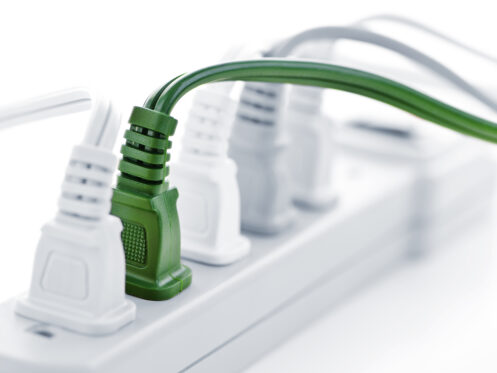Spring tends to be the rainiest time of the year in Oregon, and with all of that rain also comes a much higher chance of thunderstorms and lightning strikes. A lightning strike has the potential to cause severe damage to your home and ruin most things that are connected to your electrical system. While many people believe that using surge-protector strips will protect against damage from lightning strikes, this definitely isn’t the case. The only way to fully protect your home against lightning is with a whole-home surge protector. This article will explain the differences between surge strips and whole-home surge protection and show you why a whole-home surge protector is such a great investment.
Benefits of a Whole-Home Surge Protector
Whole-home surge protectors are relatively inexpensive, and installing one on your home will usually only set you back a few hundred dollars. This is a small price to pay considering that it would cost you much more just to replace your TV or computer if it got destroyed by an external power surge. An external power surge has the potential to do tens of thousands of dollars in damage. Not only would you normally have to repair or replace all of your electronics, but there is an extremely high chance that a lightning strike would damage or destroy your HVAC system and all other major appliances.
External power surges will also typically do extensive damage to a home’s electrical system. Any time too much current flows through a wire, it causes the wire to quickly heat up and potentially start melting. This creates an extreme risk of a fire and can also ruin the wire and force you to pay to have some or all of your home’s circuits rewired. Lightning strikes and other external surges are also likely to ruin at least some of your outlets, light switches and light fixtures and force you to replace them as well. By installing a whole-home surge protector, you can protect your home and family against electrical fires as well as protect your electrical system and all of your appliances and electronic devices.
Why Surge-Protector Strips Aren’t Always an Adequate Line of Defense
Surge-protector strips can definitely be useful and will help protect sensitive electronic items like TVs, stereos and computers from damage in some situations. For instance, if a short circuit occurs that causes the current to spike, the surge strip will “clamp” and redirect the current into the outlet’s ground wire. This prevents the electrical surge from flowing into anything that is plugged into it so that the excess voltage doesn’t cause major damage.
The problem is that surge strips are generally only robust enough to protect against internal power surges, which are surges that originate within your home’s electrical system. An external power surge caused by something like a lightning strike is almost always much more powerful than an internal surge. It can easily send thousands of volts of electricity surging into your home.
The amount of energy any type of surge protector can handle is measured in joules, which is a measurement of how much electricity flows per second. High-quality surge strips are typically rated to withstand 2,000 to 3,000 joules before they fail and stop working. Power surges have a cumulative effect on surge protectors. This means that every surge that the strip protects against takes away from the total number of joules it can protect against. This means that a strip rated to protect against 3,000 joules would fail after getting hit with 10 surges of 300 joules each or one 3,000-joule surge.
A typical lightning strike releases more than 1 billion joules of electricity in a split second. This amount of energy wouldn’t be sent surging into your house even if it was directly hit by lightning. Nonetheless, almost any external power surge would far exceed the amount of joules that even the very best surge strip can protect against. This means that the strip would instantly fail and the current would surge into your electronics and almost certainly ruin them.
Another thing to consider is that many of your major appliances are hardwired, which means there is no way to connect them to a surge strip. This means that they would also likely suffer major damage or get destroyed if your house was ever hit by a large external power surge.
How Whole-Home Surge Protection Works
Surge-protector strips are still a great line of defense since around 80% of power surges are internal surges and whole-home surge protectors only provide defense against external surges. Nonetheless, you’re still better to combine the two so that you have protection against both internal and external surges.
A whole-home surge protector is installed just before a house’s main electrical panel. This means that the electricity flows through the surge protector before flowing into the panel and around the home. The device essentially measures the voltage of the current flowing into the home and will activate almost instantly if the current ever exceeds its “clamping” voltage. This immediately prevents the surge from flowing into the home to protect both the electrical system and everything that it powers from any damage.
Modern homes are connected to the electrical grid with two 120-volt wires so that the house has both 120-volt and 240-volt power. A good whole-home surge protector will have a clamping voltage of 400 volts or less. If an external surge occurs and the current spikes above the surge protector’s clamping voltage, it will activate and redirect all of the excess power into the home’s grounding rod. This leads to the current flowing and safely dispersing into the ground outside the home instead of surging inside the house.
There are actually two different types of whole-home surge protectors: Type 1 and Type 2. A Type-2 device is installed at a home’s electrical panel as we previously mentioned. Type-1 surge protectors are instead installed at the power pole and located in between the main electrical grid and the wire that supplies power to your house. Type-1 surge protectors are rarely used nowadays since they have a much higher clamping voltage than Type-2 devices. This means that they don’t provide nearly as much protection since they may let a smaller surge flow into your home that could still cause extensive damage.
Most Type-2 whole-home surge protectors are rated to handle an external surge of at least 40,000 amps. Anything above this and the surge protector will essentially burn out and stop working. An average lightning strike usually contains anywhere from 5,000 to 30,000 amps of electricity. The most powerful bolt of lightning ever recorded was measured at approximately 100,000 amps, and no surge protector would ever protect against a surge this powerful. Nonetheless, a good whole-home surge protector should still protect against the vast majority of lightning strikes and most other external power surges.
Trust the Professionals
3 Mountains Home Services provides top-notch electrical and plumbing services throughout the Milwaukie area. Our team is ready to help if you want to upgrade your home with a whole-home surge protector and with any of your other electrical and plumbing installation and repair needs. To schedule an appointment to install a whole-home surge protector for your house before the spring thunderstorms arrive, contact us today.


